To coincide with the UN General Assembly last week, more than 2,000 climate advisers, business leaders and politicial figures gathered to find ways to accelerate the path to net zero. Here are some of the themes they discussed at the Climate Group’s conference
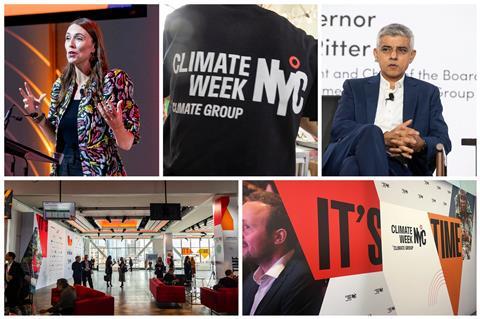
New York’s frenetic pace ratcheted up last week with one of the US’s biggest ever security operations, as it hosted world leaders for the UN General Assembly annual meeting. Global tensions, particularly in the Middle East, explain the tightened security measures in place to protect thousands of attendees, among them Israel’s prime minister Benjamin Netanyahu and our own Keir Starmer.
Noise levels peaked as NYPD sirens signalled the passing of world leaders’ motorcades, while drivers in grid-locked traffic honked horns and overhead helicopters thudded across the Hudson River delivering yet more diplomats to the UN’s headquarters.
Into this heightened atmosphere delegates were also arriving for Climate Week NYC on the opposite side of Manhattan’s Midtown area. Some 2,000 political figures, business leaders, climate advisers and senior decision-makers had the pick of more than 900 events taking place in person and online, all focused on top-level strategic thinking to accelerate climate action around the world.
The Climate Week conference, which opened at The Glasshouse on 12th Avenue with a speech from former New Zealand prime minister Jacinda Ardern, was themed around the urgency of the climate crisis. The Climate Group, the event organiser, works in partnership with the UN General Assembly – hence the reason for holding it last week – and it chose to highlight three key messages: “It is time to course correct. It is time to speed up. It is time to finish the race”.
I believe not only that things can be better but that they must be. That politicians, policymakers, the private sector, financial institutions will respond to the challenge
Jacinda Ardern, speaking at Climate Week NCY
Positivity was evident from the outset, as Ardern explicitly called on delegates to resist those who view optimism as naive or dangerous: “I believe not only that things can be better but that they must be. That politicians, policymakers, the private sector, financial institutions will respond to the challenge in front of us, through the sheer magnitude of what will happen if they don’t.”
Nevertheless, a common theme of many of the subsequent discussions was the sheer scale of the challenges and demands posed by the necessary green transition of economies across the globe. An underlying frustration was evident among many speakers as they warned of examples in business and in government that showed the alarming distance between intentions to tackle the climate crisis and tangible results.
If the point about taking climate change seriously needed underlining, then delegates only had to turn on the news to hear about the impending damage to be wreaked by hurricane Helene as it hit the Florida coast. If anything the devastation has been worse than expected, affecting five states in the south-east, killing more than 60 people and causing billions of dollars of damage.
Topics at Climate Week covered everything from corporate transparency and the role of leaders to climate finance and the impact of AI, with all sectors represented including the built environment.
��ɫ����TV hosted its own roundtable debate with a full range of construction professionals, held in association with the Climate Group and supported by Gleeds, on the dual pressures to decarbonise the built environment that are coming from investor demand and regulatory change. A full account of their views on overcoming the barriers to greener buildings and infrastructure will be published soon.
In the meantime, here is a quick guide to some of the topics and themes that caught our eye during Climate Week NYC:
Role of governments in driving innovation
Leveraging size and scale
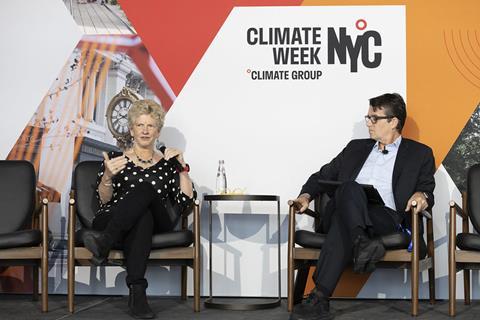
The location of Climate Week in New York meant many of the speakers looked at the net zero agenda through a US lens, and clearly President Biden’s flagship Inflation Reduction Act has been a big boost for those who back the mantra “government-enabled, private-sector-led” climate action – seeing public investment as a way to kick-start innovation in markets that would struggle to make a green transition otherwise.
In an on-stage interview Robin Carnahan, administrator of the General Services Administration (GSA), which is the operations arm of the US federal government, talked about how she is leveraging its buying power to drive market demand for low embodied carbon materials.
The GSA has the biggest building portfolio in the US and is the biggest buyer of goods and services, with purchasing power worth US$100bn, which she said means it can send “demand signals” to the market. She said the Inflation Reduction Act provided the GSA with US$2bn to reduce embodied carbon in its supply chain and, as a result, it has focused on concrete, asphalt, glass and steel.
Government can lead by example, particularly in the built environment [where] no one wants to take any risk on anything
Robin Carnahan, General Services Administration, US federal governent
She said: “Government can lead by example, particularly in the built environment [where] no one wants to take any risk on anything. It’s really all about de-risking things, and that means using proven technologies and products. And, if so, if we can prove those in our buildings, it makes it easy for the rest of the market to adopt it, and that’s when scale happens.”
She also talked about the GSA’s role in piloting technology, for example in Oklahoma City, where they have their first grid-interactive, efficient federal building. It has solar panels on the roof and “big batteries, interconnected with the grid. So, if Oklahoma Gas and Electric needs to do some load shedding or shaping, they can tap into our battery at that building.”
Action led by local leaders
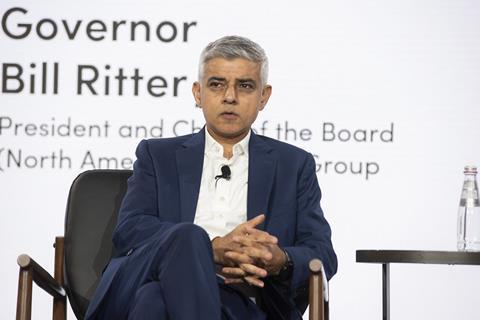
At a sub-national level, some leaders believe they are able to drive action on climate more rapidly than national governments. According to London mayor Sadiq Khan, cities have been more successful in finding the right incentives to drive green economies than at the national level.
Khan, who also co-chairs the C40 network of cities, referred to UN secretary general Antonio Guterres’ description of cities as “the first responders to the climate emergency”.
He said: “The evidence over the last few years is countries have been delaying taking action […], whereas cities have been taking action. We are the doers versus the delayers.”
Cities have traditionally invested in fossil fuels through pension funds but the mayor said that 20 cities are now actively divesting in oil, gas and coal.
In a different panel discussion Gillian Martin, the Scottish government’s acting net zero minister, said political leaders should cut red tape when awarding climate funding to ensure communities get value for money. She highlighted the need for governments, whether national or regional, to show a commitment to spending public money on climate initiatives in order to attract finance from the private sector.
She said: “If governments are putting money in […] that shows that there’s a system in place, that money is actually going to be going to communities and we can be […] offering the opportunity to match-fund what governments are doing and maximise their development too.”
Importance of verifiable global standards

In order to get to net zero, all organisations in society need to make a transition to reach some challenging goals. That transition will not happen on its own, and requires a governance structure, which was discussed in a Climate Week session focused on international standards.
A key point of discussion was the need businesses have for standardised approaches globally that are trusted and independently verifiable. Currently there are many initiatives to measure different aspects of the green transition such as the Science Based Targets initiative for net zero target setting, the Greenhouse Gas Protocol to measure emissions and the International Sustainability Standards Board, which sets standards for climate-related disclosure.
Right now, ISO is developing its first ever international standard for net zero for organisations
Shana Gallagher, British Standards Institution
Shana Gallagher, net zero engagement manager at the British Standards Institution (BSI), argued that it can be difficult for those who want to take climate action because they have to piece together information from this fragmented landscape, often referred to as the “alphabet soup of net zero frameworks”.
She cited the Net Zero Tracker’s 2023 report which said just over 1,000 of the world’s largest businesses have set a net zero target, and of those only 4% have strategies in place to achieve their goal. International standards are seen as the principal way to ensure businesses have a clear pathway to take meaningful action while also guarding against greenwashing.
With this in mind, BSI’s Gallagher said an upcoming global standard will make it possible to prove progress to suppliers, shareholders, financiers, staff and the public: “Right now, ISO is developing its first ever international standard for net zero for organisations”.
She said this new standard is based on the ISO net zero guidelines, adding: “Once this international standard launches – which is expected to be at COP30 at the end of 2025 – it will allow this very powerful international standards system and quality infrastructure […] to be leveraged to scale and accelerate net zero action.”
The hope is that this new ISO standard will also help drive change within organisations because ISO is widely recognised among senior leadership teams who might not be sustainability experts.
The panel put out a call to action for those in the industry to contribute to the public consultation on the draft standard, which will happen next year. Other suggested ways to get involved included contacting national standards body or joining a national climate change management standards committee.
Changes in approach to shift the dial on carbon emissions
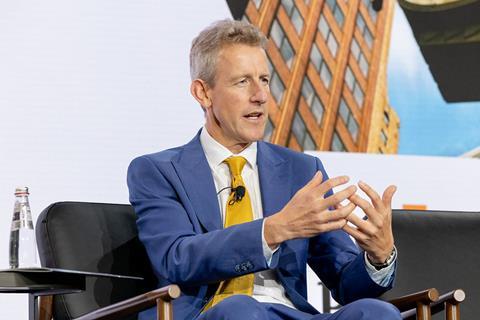
Several sessions and reports published as part of Climate Week NYC highlighted the importance of those in the built environment adapting their work in order to minimise the sector’s contribution to climate change.
One such publication provided guidance for a consistent approach for estimating greenhouse gases impact of built environment professionals’ designs and advisory work.
The report, backed by big names such Aecom, Arup and WSP, says that designs and advice represent the largest greenhouse gas impact of the environmental and engineering sector, stating that, according to the UN environment programme. buildings and the construction sector account for .
Published by Pledge to Net Zero, in conjunction with Climate Week NYC, to estimate the greenhouse gas impact of their work, each with different levels of detail and purposes.
The crucial thing is it’s mandates that are the most powerful and effective policy […] bringing forward positive tipping points not just in their sector, but across sectors
Tim Lenton, University of Exeter
Meanwhile, another report launched at the event has called on governments to start a global cascade of “positive tipping points” to cut prices and carbon emissions by using mandates to switch investment from polluting fossil fuels to clean technologies, such as heat pumps.
The examined four sectors: power, heating, light road transport and heavy road transport.
Professor Tim Lenton from the University of Exeter (pictured above) said the report had compared three types of government policy: taxes, stimulas packages and mandates. He added: “The crucial thing is it’s mandates – like you’re not going to be able to sell the petrol and diesel cars in our market in 2035 – that are the most powerful and effective policy […] bringing forward positive tipping points not just in their sector, but across sectors. Because they’re the thing that can really stimulate innovation and set that clear path.”
It recommended the following mandates:
- Require a rising proportion of heating appliance sales to be heat pumps from 2025, reaching 100% by 2035
- Phase out coal power by 2035 for developed countries and by 2045 for developing countries
- Require a rising proportion of car sales to be zero-emission vehicles, reaching 100% by 2035
- Require a rising proportion of truck sales to be zero emission vehicles, reaching 100% by 2040.
Built assets and risk

How big is the risk posed by the energy transition and climate change to our built assets? That was one of the questions posed during an event organised by JLL and the Financial Times.
Lori Mabardi, ESG senior director at Barings Real Estate, took the view that 2025 will be the year that we reach “a tipping point when the risks become more real” for investors. She has next year in her sights because that is when a raft of regulations come into effect and it is only five years away from many corporations’ 2030 interim climate goals.
She said that four decades ago extreme weather events accounted for US$220bn of extreme property damage. In the past four years that sum has more than doubled to about US$560bn.
Ultimately her point was that the more climate awareness becomes mainstream, the more it will hit property valuations. She also said that whether you are a tenant, buyer or insurer of property, if you cannot get insurance the risk you face is one of liquidity.
Francesca de Quesada Covey at Miami-Dade County in the state of Florida pointed to the example of Hurricane Andrew in 1992, which resulted in the area changing its building codes. At the time the private sector had been worried the changes would stifle the development and the wider economy but that has not happened and instead, she said, Miami-Dade has become the standard-bearer for building codes across the US and is now focusing on resilient infrastructure.
Guy Grainger, global head of sustainability services and ESG at JLL, outlined some of the challenges that are confronting building owners and occupiers. He said in the current market they face higher costs and falling property values which represent “real survival issues” on top of some “pretty scary climate targets”.
In Grainger’s view, those working in real estate need to “acknowledge we are part of the problem, […] we have made no dent in emissions cuts”, meanwhile the supply of net zero carbon buildings is diminishing but demand is increasing.
Ending on a more positive note he suggested that the gap between supply and demand could be a “golden opportunity” for smart building owners with access to capital.
Decarbonising materials and moving away from fossil fuels
Halting investment in gas, oil and coal

Tzeporah Berman, chair of the Fossil Fuel Non-Proliferation Treaty, was clear that the world is still moving in the wrong direction. She said that while world leaders have been negotiating emissions and targets for decades they are allowing the production of fossil fuels to grow.
“Right now we’re on track to produce 110% more oil, gas and coal by 2030 than we could ever burn if we want to stay below 2°C [the widely adopted maximum global temperature increase threshold],” she said.
“They [fossil fuel companies] are the most profitable companies on Earth, and they have made US$2.8bn every day, for the past 50 years, according to the World Bank data. So we need to figure out how to move some of that wealth to get countries the support they need in order to support economic diversification.”
She said that, while the phase-out of coal, oil and gas required different approaches, capital investment in all three has to be stopped.
Concrete and steel
Tech giant Meta announced at Climate Week that it has moved into investing in low carbon concrete production in an attempt to reduce the embodied carbon used to build its data centres.
Facebook’s parent company announced the agreement with CarbonBuilt, a company that has developed a concrete product replacing high-carbon Portland with a proprietary low-cost cement alternative.
Called Reversa, the product is made from widely available low carbon material that hardens after chemically reacting with CO2. This process strengthens the concrete blocks and also permanently stores the CO2, diverting it from the atmosphere.
CarbonBuilt says its product enables customers to reduce their carbon footprint by up to 70% compared with industry baselines without affecting price, performance or plant operations.
Concrete as well as other key hard to abate industries represent a big chunk of the embodied missions associated with the data centre infrastructure
John DeAngelis, Meta
Meta’s capital investment will be used by CarbonBuilt, set up four years’ ago, to upgrade two new concrete plants in Arizona and Alabama in the US.
John DeAngelis, head of clean technology innovation at Meta, said: “Our global infrastructure is what enables us to deliver the products and services that billions of people use around the world, and data centres play a big role in that.
“But concrete as well as other key hard to abate industries represent a big chunk of the embodied missions associated with the data centre infrastructure.”
Meanwhile, Outokumpu, a stainless steel company that says it now bases its business on the circular economy and is using 95% recycled material in its production process, provided an update on its carbon goals. As part of a panel discussion Marc-Simon Scharr, chief financial officer, said the firm aims to reduce emissions by the end of the decade by 42% against the baseline of 2016, having 27% of that target to date.
He said the ultimate aim is to be carbon neutral, adding: “Profitability and sustainability are not mutually exclusive, and should and can go hand in hand, but it requires clear commitment from corporates and especially from the top”.
While conceding innovative products do come at a premium, he argued that the focus should be on cost of not investing in carbon reduction. He said “For me, this is more a licence to operate question than anything else.”
Willingness to pay
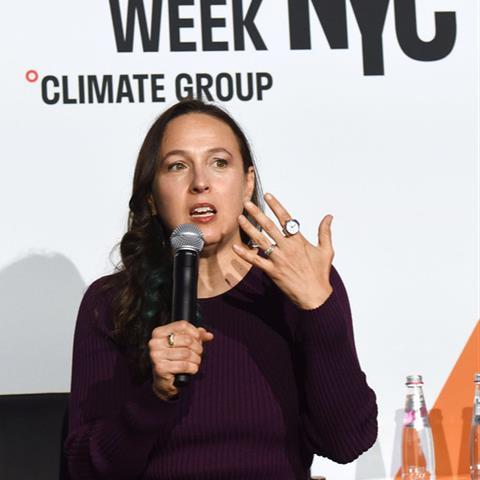
Research released from Ramboll and the Climate Group revealed more customers are willing to foot the bill for sustainable products, such as lower carbon concrete and steel, than they were a year ago.
The research indicates growing momentum, with 45% of respondents saying they would be willing to pay more for emissions reductions of 25% or higher for steel, while 57% would be willing to do so for emissions reductions exceeding 50%. For concrete, these numbers were 40% and 49% respectively.
Compared with one year ago, 52% of respondents had a higher willingness to pay more, while 34% reported no change in their stance, according to the report entitled .
The research is based on more than 250 companies from 42 countries and 21 industries. The companies were surveyed on their current readiness to use and willingness to pay for lower emission steel and concrete.
However, cost barriers do exist for many in the supply chain as do other challenges. Rahul Shendure, chief executive at CarbonBuilt, which received Meta’s capital funding mentioned above, said the structure of the concrete market is delaying the uptake of low carbon solutions. He said: “It’s a hyper local business made up of small, medium sized companies, very low margin. […] We have to make this [low carbon solutions] profitable for a producer so that they want to make all their concrete this way.”
We’re trying to solve this issue where there isn’t large scale project finance. Concrete is not a great fit for traditional project finance
Sara Neff, Microsoft and The New Concrete
Sara Neff, who recently left Lendlease for Microsoft and is now also co-director of The New Concrete, talked about a new decarbonisation recoverable grant for low carbon technologies to help bridge the affordability gap in places.
She said: “We’re trying to solve this issue where there isn’t large-scale project finance. Concrete is not a great fit for traditional project finance. The historic cash flows are difficult. Willingness to pay is tough. There’s just a lot of high capex. And so we decided to launch this fund focused on philanthropic and institutional capital to come in and be that catalytic capital through the recoverable grant.”
Linking back to the theme of optimism at the start of the conference Neff struck a hopeful note, saying: “Concrete is great because it is the second most impactful investment anybody can make in carbon avoidance. The first one is alternative meat. […] Concrete is a solvable problem. It’s a fast problem. We can get there.”


























No comments yet